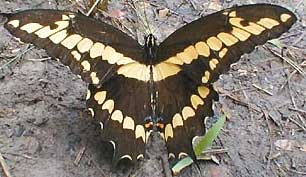

Giant Swallowtails -- show above -- along with the Thoas and female Tiger swallowtails are the largest North American butterflies. When their wings are folded up, showing their undersides, they are mostly yellow, but when the butterfly spreads its wings as in the picture it's mostly black. Just imagine being a predator about to pounce on this critter when it opens its wings and what looks like the big yellow lips of a grinning mouth confront you! This butterfly's caterpillar looks like a bird dropping! The caterpillar also feeds on various citrus trees, so in southern states where oranges and lemons are produced, sometimes this beautiful butterfly is considered a pest and is sprayed with massive dosages of pesticides!
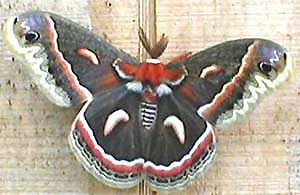
My Mississippi neighbor Karen Wise found both this and the next two beauties in her backyard, photographed them with her digital camera, sent them to us. Cecropia Moths are one of the prettiest of all insects, and with a wingspread of 5 to 6 inches (12.5-15 cm), one of the most spectacular. Adults emerge from their overwintering cocoons in early summer, then late at night the female emits a scent called a pheromone that attracts a male moth. The male senses the pheromone with his antennae, and he can do this from a mile away! Caterpillars emerging from the resulting eggs are tiny but they take the whole summer to grow into very large, chubby ones. They feed mainly on cherry, plum, apple, elderberry, boxelder, maple, birch and willow, but will also feed on linden, elm, sassafras and lilac. In late summer the caterpillar spins its large, brown, weatherproof cocoon, in which it will stay until it emerges the next spring, when the cycle begins all over again.
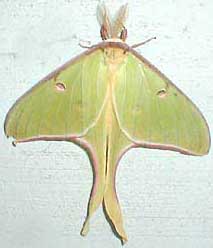
Notice that both this Luna Moth and the above Cecropia Moth are members of the Saturniidae, the Giant Silkworm Moth Family. This is surely the most famous moth family simply because so many of its species are large and very colorful. A good place to learn more about the family is Bill Oehlke's Large and Showy Moths (Saturniidae) of North America. If you find a North American moth you suspect to be a Saturniidae, you may be able to identify it by going through the more than a hundred thumbnail photos of North American Saturniidae at the USGS's Butterflies and Moths of North America Web site.
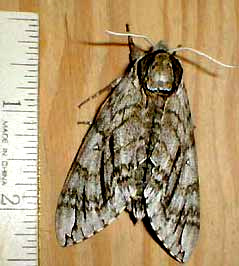
This big moth isn't as spectacular as the above Saturniidae but in many ways it's more interesting because it's much less known and easy to identify than the above species. I had to thumb through over a hundred thumbnails at the USGS's Butterflies and Moths of North America Web site before I found this one, and I'm here to tell you that lots of moths have a color and pattern similar to the Waved Sphinx, but only the Waved Sphinx has the exact combination shown here. The clinching field marks for this species is the arrangement of the brown and gray patterns. The broad, brown band at the bottom of the wing with a gray streak going through it is the easiest field mark to notice, and then you confirm the identification by looking for that little pale dot outlined in dark brown in the wing's center. This is the first time this moth has been recorded in our county, so we sent the photo to the "state expert" listed at the Moths of North America site, so if someday you see a distribution map showing that the Waved Sphinx Moth is found in Adams County, Mississippi, that's us!
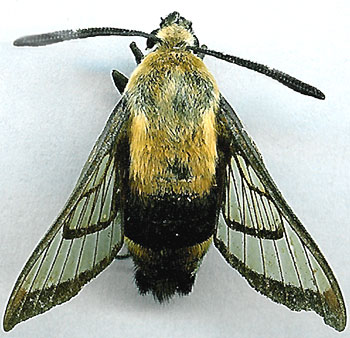
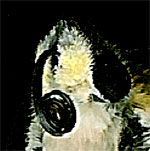 When this species hovers at flowers taking nectar you might mistake it for a hummingbird. If it lands and you see its fuzzy, black and yellow back and wings with large transparent areas, you might think it's a Bumble Bee. However, it's as much a moth as it can be, as its thick antenna and coiled feeding tube, or proboscis, prove. Its coiled proboscis is shown in the close-up of its head below. The species is found throughout eastern North America. Its caterpillars are green "hornworms" somewhat like the one shown below, except without the white stripes. In Louisiana the species produces six broods a year, at 30-day intervals, with the first brood peaking at the end of March. Farther north there are fewer broods. The caterpillars feed on viburnum and related species, and the adults take nectar from many kinds of flower.
When this species hovers at flowers taking nectar you might mistake it for a hummingbird. If it lands and you see its fuzzy, black and yellow back and wings with large transparent areas, you might think it's a Bumble Bee. However, it's as much a moth as it can be, as its thick antenna and coiled feeding tube, or proboscis, prove. Its coiled proboscis is shown in the close-up of its head below. The species is found throughout eastern North America. Its caterpillars are green "hornworms" somewhat like the one shown below, except without the white stripes. In Louisiana the species produces six broods a year, at 30-day intervals, with the first brood peaking at the end of March. Farther north there are fewer broods. The caterpillars feed on viburnum and related species, and the adults take nectar from many kinds of flower.
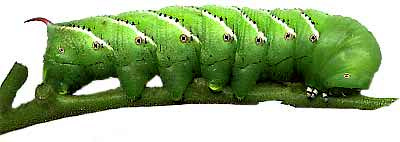
Some butterflies and moths are better known in their caterpillar stage than in their adult form, and that's the case with the Tobacco Hornworm. The adult moth of this species is somewhat similar to the above Waved Sphinx Moth -- they're both members of the Sphingidae. This caterpillar is a big one -- 3 to 4 inches long (75-100 mm), nearly as large as it appears on your screen -- and eats enormous amounts as it grows. The above hornworm was found on one of my tomato plants where each night it ate about two large leaves. At first I assumed he was the similar-looking Tomato Hornworm, Manduca quinquemaculata, but Tomato Hornworms have black "horns" while Tobacco Hornworms have red ones, and you clearly see that this critter has a red horn.
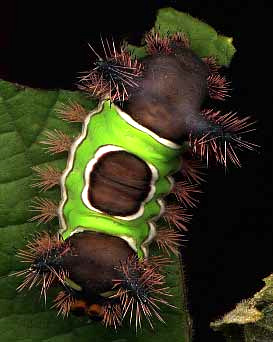
This little caterpillar 7/8-inch long (22 mm) is famous not only because it's so pretty and fairly common at forest edges, in orchards and in vegetable gardens throughout most of the eastern US, but also because if you brush against those sharp hairs it'll hurt as bad or worse than if you'd been stung by a bee! Those spiny hairs you see bristling from the caterpillar are hollow and connected to underlying poison glands. The hairs are like hypodermic needles that inject poison into your skin. The irritation can last for a day or two and may be accompanied by nausea during the first few hours. Usually the site of contact reddens and swells much like a bee sting. Anyone who gets
"stung" should immediately wash the affected area to remove any remaining hairs and poison. 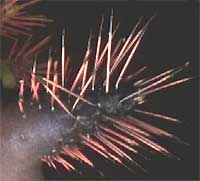 An ice pack will help reduce swelling, and creams and lotions containing steroids will lessen the discomfort and promote healing. Persons known to be sensitive to insect stings should contact their physician. At the left you see a close-up of the offending spines. On the caterpillar, notice that one end bears two bright yellow spots. These spots are the rear end. If a predator isn't bothered by the stinging hairs and wants to disable the caterpillar by attacking the head, more than likely it will be attracted by these bright spots to the rear end, and this will give the caterpillar, with head intact, a better chance of escaping. This is one caterpillar that Mother Nature gave some good defenses!
An ice pack will help reduce swelling, and creams and lotions containing steroids will lessen the discomfort and promote healing. Persons known to be sensitive to insect stings should contact their physician. At the left you see a close-up of the offending spines. On the caterpillar, notice that one end bears two bright yellow spots. These spots are the rear end. If a predator isn't bothered by the stinging hairs and wants to disable the caterpillar by attacking the head, more than likely it will be attracted by these bright spots to the rear end, and this will give the caterpillar, with head intact, a better chance of escaping. This is one caterpillar that Mother Nature gave some good defenses!